Santa Clara sits near the top of a county-wide list for property value growth.
While Santa Clara saw a 7.32% increase, Sunnyvale wasn’t far behind with 6.07% growth, according to figures released by the Santa Clara County Assessor’s office earlier this month. Santa Clara’s assessed value increased from $61 billion to $65.5 billion, while Sunnyvale increased from $67.5 billion to $71.6 billion.
Only Mountain View, with 7.69% growth, saw a bigger increase.
Changes in this growth represent shifts between January 2023 and January 2024.
New construction, specifically large-scale developments, is central to the assessment, bolstering property values in cities. This increase in assessed value is known as “roll growth.”
For instance, a Related California development, set to be located at 5150 Calle del Sol in Santa Clara, added $202.8 million to the roll. That development bumped Santa Clara to No. 2 on the growth list.
“These areas that are highly dense, with a lot of commercial property, are the ones expanding,” said Santa Clara County Assessor Larry Stone.
With increases in residential property values in Santa Clara and Sunnyvale comes an increase in property tax collected. The biggest winners in a situation where residential property values increase are the K-12 school districts, which receive 27% of that money.
Despite the common perception that high-density, below-market-rate housing reduces existing property values, Stone said such a notion is a myth.
“Low-income housing, if it is well-constructed and well-managed, never decreases the market values of homes,” he said.
In 2023, residential property values in the county declined but rebounded in 2024. Residential property values are now the highest in the country.
The other major contributors to an increase in property values is a change of ownership and state regulation. Ownership change accounted for 42% of this year’s growth, according to the Santa Clara County Assessor’s Office.
“The value of residential property is based on fair market value,” Stone said. “When we do an assessment, we look at comparable sales on comparable property.”
A state law, Prop. 13, caps the increase in value of properties lacking “new activities or transactions” at 2% or the California Consumer Price Index, whichever is lower.
In 2023, the assessor proactively reduced the values of 17,000 residential properties. However, this year, more than half of those saw restoration to their previous values.
While residential property values continue to soar, Stone said commercial and industrial values are floundering. For cities that have a high degree of these types of properties, Stone said, “the future will look different.”
Although unlikely, he said it could even affect residential property values if those properties are part of mixed-use developments where the appeal of the housing is contingent on vibrant commercial property.
“If the neighborhood, for whatever reason, whether it is commercial or industrial … doesn’t provide the amenities in the area it is in, it could affect those residential properties near it,” Stone said. “If the value of commercial property declines through improper maintenance and not providing commercial services, retail services, for instance, it can negatively affect residential values.”
Related Posts:
Santa Clara Zoning Code Update Ends Planned-Development Era
Downtown Sunnyvale Hits Milestone in Development
